#both to the novel her ability is named after as well as a reference to natsume sensei since in universe fukumori named her after him
Note
🍼+ fukumori
i had a feeling you'd ask for them.
I've only had [twins Natsuki and Mari] for a day and a half, but if anything happened to [them], I would kill everyone in this room and then myself.
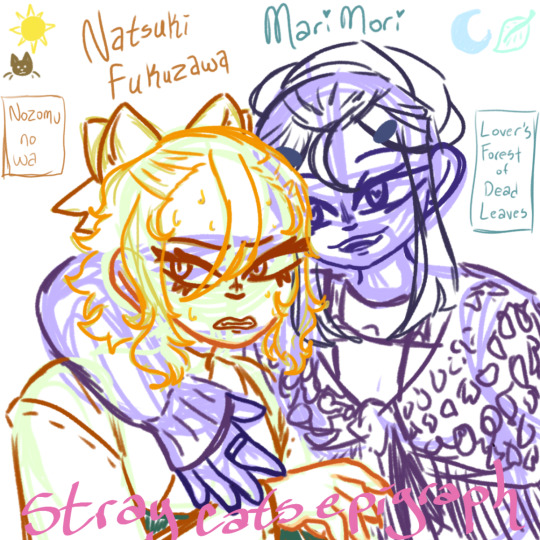
Nozomu no wa: A shapeshifting ability that allows Natsuki to take on physical traits of various animals, whether as a partial or full transformation, depending on the type of ballet she performs.
Lover's Forest of Dead Leaves: A bonsai tree capable of growing an exact replica of a destroyed item at the price of being offered blood from the person who desires the replicated object. This only works if the object has been destroyed beyond repair or recovery rather than just lost, but the object can range from something as simple as a fully burnt out candle to something as complex as the recently deceased. The more complex the replication, the more sacrifice is required to complete it.
Send me 🍼 + a ship and I’ll draw/make a fan-child
#oc: mari mori#oc: natsuki fukuzawa#fukumori#bsd fankid#bsd nextgen#bungo stray dogs#bsd#portrait of a gallery#making a visual pun by making mari's preferred fashion sense be in the style of mori kei#also natsuki doesnt have any actual animal ears those are just a bow meant to give her the shape language of a cat as reference#both to the novel her ability is named after as well as a reference to natsume sensei since in universe fukumori named her after him#(stole the first character of his last name)#natsuki is a trans girl#and mari likes to use “boku” as her personal pronoun when speaking japanese#(once again you cant tell me both of those old men arent pushing for being at least bilingual if not more so)#stray cats verse
14 notes
·
View notes
Text

judith, a witch(?!) in a pact with a malak named ba’ul
more info and reference sheet under the cut!
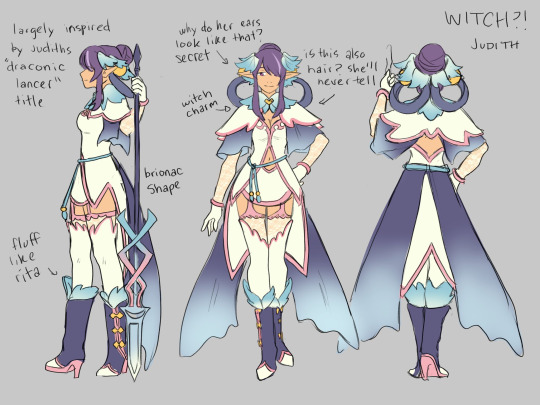
here she is!! i'm happy with her look, less so with the rendered image of her, but we can't win them all.
like it says on the sheet, i was taking a lot of cues from her in game Draconic Lancer title costume. I wanted to lean into the white more than her default outfit, calling back more to the helmeted look she has before joining the party. but obviously, i didnt want to do anything that looked too much like that, or that had gold accents like her in game jacket and...skirt cape(??), because then she'd come off as kind of abbey coded. so i settled on pink accents, pulling from the colors on the Draconic Lancer look. i think it's fun. it gives her a girlish touch, which is a part of judy's character that i like! she's badass and secretive and mysterious, but she likes cute things too. well. her idea of cute, anyways...i think it suits her persona of being a "witch" in this setting. judy understands how to create an image.
speaking of that. unlike rita, who has a lot of magical knowledge, judy is basically a witch in name only. she understands how to form a pact, and not a lot past that! i think we landed on this for a few reasons:
Judy's father, Hermes, was a blastia expert, and naturally good at the magic of vesperia's universe. but judy was just the opposite, and in the novels she initially couldn't even grasp the talents natural to most krityans. being a witch who doesn't actually do much magic seems apt.
speaking of her dad, this also provides her connection to rita. they're both...witches. rita WILL NOT call judy a witch though, as you might imagine LOL (on that note, maybe hermes takes on the role of grim as the witch teacher?? again, we havent really decided on this LOL)
ba'ul obviously makes most sense as a malak, since the malaks and the entelechaia are both spirit equivalents for these tales entries. (well, entelechaia become spirits--listen, you get what i mean if you've played enough tales games) and judy MUST be with ba'ul! much like she only learns how to use her nageeg after interacting with ba'ul in the novel, i think she has just enough resonance to meet ba'ul, and their connection increases it, and she refines that ability as a "witch" enough to solidify their bond through a pact. they're family!
But yeah she uses a spear to fight. Ba'ul helps her imbue it with seraphic artes to a degree, but mostly its just the spear. I went with a design similar to the Brionac, since that's her Lore Important Weapon, but uh, i haven't designated this lance with lore importance itself. maybe we'll come up with something. looking at it right now i really think i should've colored it differently but IM NOT CHANGING IT, I ALREADY POSTED TO TWITTER!!! (it may change, hell, i decided to make it kind of glow pink in the image, im not fit for weapon designs)
Ba'ul always comes first to Judy, but neither of them is particularly biased against daemons or humans, despite knowing the truth about malevolence. she's quick to befriend yuri and loves repede (who is also a daemon, i gotta put him down on paper soon) and seems understanding of people's different circumstances. but she prioritizes her own goals first, so she'll disappear at the drop of a hat if it suits her, and yuri knows better than to count on her too much...
oh yeah. ba'ul is considered a "dragon" in vesperia, but that comes with a lot of BAGGAGE in this universe, so he's not a dragon here. he, um....he just looks like that. it's fine.
84 notes
·
View notes
Text
Malleus Info Compilation part 12: Malleus, Deuce and Riddle
Malleus and Deuce have the occasional overlap: In a Halloween voice over Deuce describes Malleus as “even more gallant than usual" in his costume, and Deuce is Malleus’ judge in Culinary Crucible.
In a vignette Cater sends Malleus to Deuce to fix a technological issue that Malleus has and Deuce, initially, prepares to brawl.



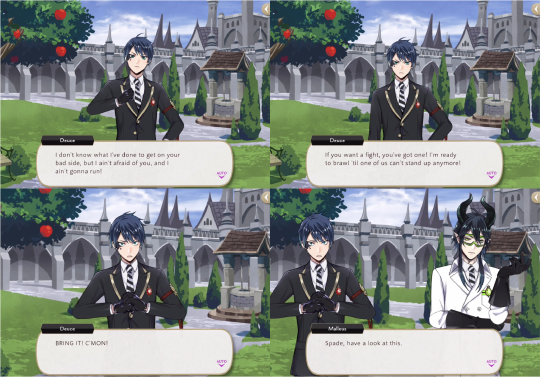


(Note: when Malleus summons fire to help dry out the damp inner workings of the device, the color of the flames are orange on NA but they were originally blue on JP. Visual changes are usually corrections of mistakes made on JP due to oversight or time constrictions. It is my theory that the blue fire is supposed to be unique to Grim, Idia and Ortho because it is not normal fire, making it a continuity error that Malleus had been able to summon whatever it is with plain fire magic. Hence the correction for NA.)
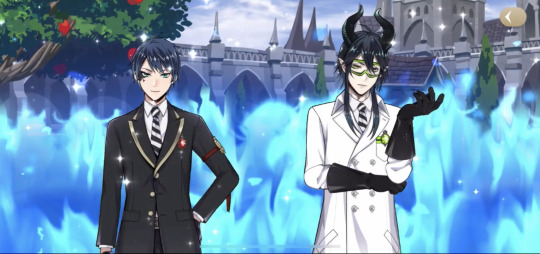
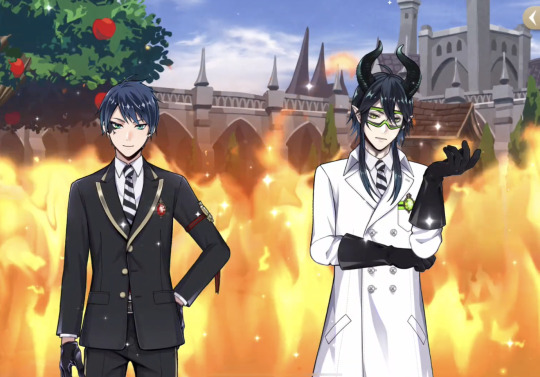
Deuce successfully fixes Malleus’ device and Malleus explains how fully mechanical objects are rare in Briar Valley, as “most of what we use is technomancy”, and how he barely remembers any of his childhood. Malleus gifts deuce with a rare ore for his help.


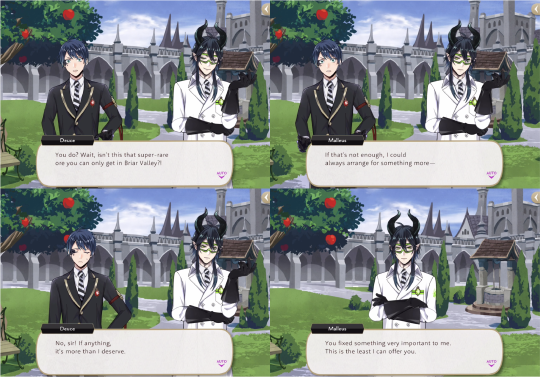
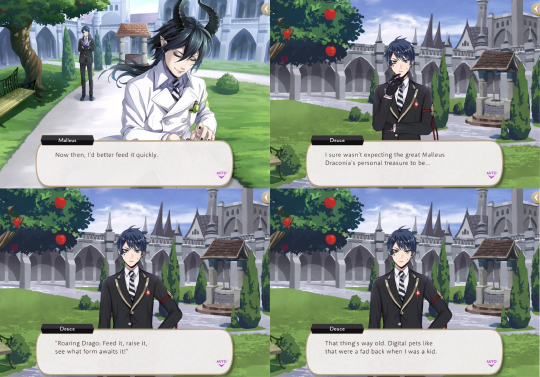
Malleus’ treasure is revealed to be a tamagotchi-style digital toy called “Roaring Drago” that Lilia got for him as a souvenir “during one of his sojourns to another land”, and his wish in the “Wish Upon a Star” event is “for Roaring Drago to make a friend”.


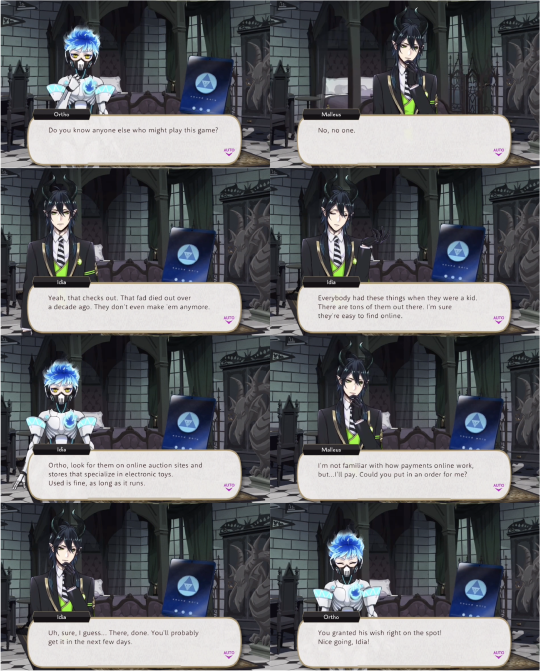
Idia grants this wish by ordering another one online. Roaring Drago is name-dropped in the Firelit Sky event as well. (Twisted Wonderland equivalents of Roaring Drago were released in January of 2021)

Malleus is also Deuce's interviewer for his third birthday vignette.
Like Malleus and Deuce, Malleus and Riddle also have the occasional overlap. While Deuce is Malleus' Culinary Crucible judge, Malleus is Riddle’s judge.
On the subject of Riddle's cooking Malleus says “the flavor and plating are both entirely pedestrian. Perhaps I expected too much.”

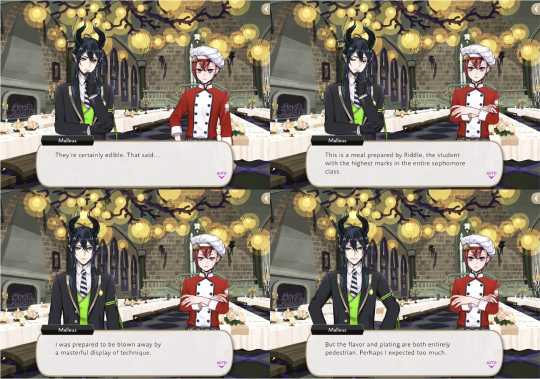
Malleus visits Riddle during Phantom Bride to thank him for fighting to save Lilia and Sebek in a conversation where we learn about “a classic Thorn Fairy anecdote” to do with frost and roses.
(this is covered in slightly more detail in novel, where Deuce shares a rumor that Malleus went to Heartslabyul on an errand and after he left, all the roses in the rose maze were found to be frosted over and wilted. It is also mentioned in FanBook 2, which says, "This is a reference to the part in Sleeping Beauty where the fairy Flora recommends disguising Aurora as a flower to hide her from Maleficent, but Merryweather cautions that Maleficient may send out a frost to kill all flowers in the land if they were to do so."

When Malleus says he suspects that Riddle must consider his conduct to be unbeffiting a leader Riddle responds, “Your position as prince of your land must come before your position as housewarden”.
Malleus concedes that as Briar Vallery’s heir apparent he “cannot enter into an engagement lightly, even on false pretense” (even to save Lilia and Sebek), but says Riddle lacks “a certain…majesty”.
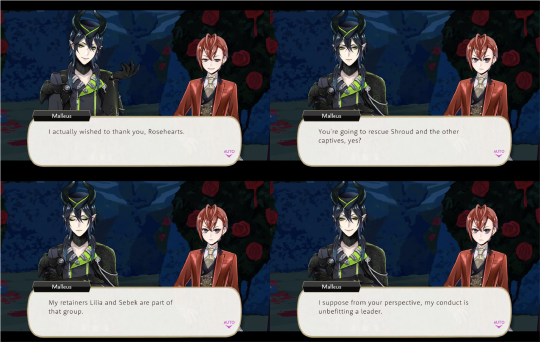
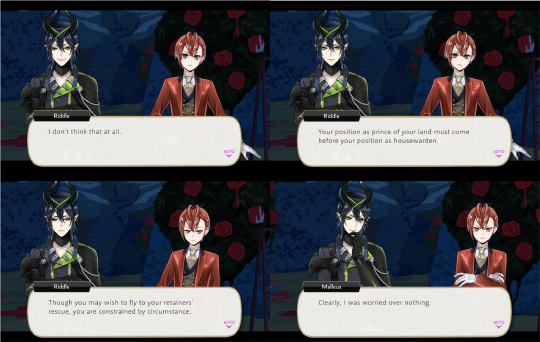
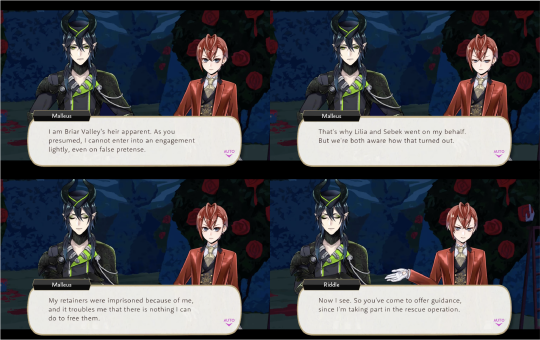


Malleus fastens one of the roses that Riddle had pruned onto Riddle’s lapel, saying, “If you are king of this rose garden, you must carry yourself with a rose’s strength and nobility”.
When Silver expresses concern for Lilia and Sebek, Malleus says he has full confidence in Riddle. Silver is surprised at how much faith Malleus has in Riddle’s abilities and Malleus says, “Faith? I am merely acknowledging the truth. After all, he is…the king of Heartslabyul.”

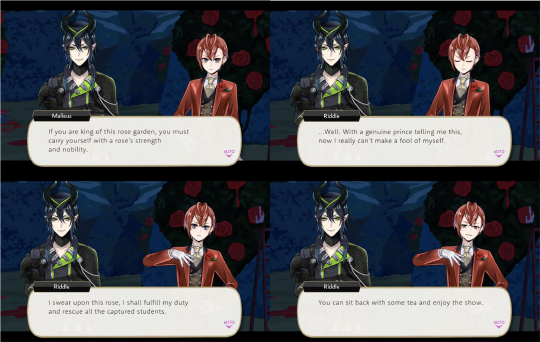



123 notes
·
View notes
Text
Analysis of BSD Tanizaki (Character and Theories) in Reference to Real Life Tanizaki Jun’ichirou
By popular demand of (1) person in the comments of a post I’ve made briefly touching on this subject, I have compiled all of my thoughts on the portrayal of Tanizaki Jun’ichirou—and by extension, Naomi—in Bungou Stray Dogs in reference to the works of the real life Tanizaki Jun’ichirou-sensei (who I’ll be calling Tanizaki-sensei to differentiate from his fictional counterpart). Disclaimer that I don’t have the academic background to write as an expert on this subject. I will be citing all of my sources in the text.
Tanizaki-sensei (1886-1965) was an author who was well known for writing about sexual obsession and fetishes, and the exploration of Japanese versus Western culture in his works. His female characters were particularly reputable for having strong personalities (drawing upon the dofuku - “poisonous woman” or femme fatale troupe), and frequently fulfilled the domineering role in sadomasochistic relationships with men. This recurring theme is most likely the basis for Tanizaki and Naomi’s relationship in Bungou Stray Dogs.

In a similar vein, motifs such as dreaming, delusions, and fantasies (oftentimes of the erotic nature) frequently appear in Tanizaki-sensei’s works. This could be the basis for Tanizaki’s illusion projection ability, “Light Snow”, which is named after Tanizaki-sensei’s great novel, Sasameyuki (1948), also known as The Makioka Sisters, the title of the English translation, which was changed due to the nuance of the original title being difficult to convey in English.
Going on a slight tangent here, Tanizaki-sensei also wrote a handful of works depicting blindness, such as A Portrait of Shunkin (1933) and A Blind Man’s Tale (1931). In these works, blindness can be interpreted as a metaphor for blind devotion and obsessive worship of one’s love interest, even to the point of martyrdom. For example, in A Portrait of Shunkin (1933), the character Sasuke destroys his own eyesight for his vain mistress, who did not want to be seen after an incident destroys her beauty. Tanizaki and Naomi’s deep affection for each other is reminiscent of these themes (Tanizaki’s willingness to throw away his morals for Naomi, Naomi taking gunfire in Tanizaki’s place).
Unfortunately, we aren’t given any other concrete pieces of information about Tanizaki or Naomi that can be reliably connected to something in regards to the real life author...
The Unreliable Narrator
Which brings me to my first point in regards to fan theories surrounding Tanizaki and Naomi. I have mentioned in previous posts that Tanizaki’s descriptions of himself oftentimes contradict what we are actually shown (not good for combat, cowardly and average, etc), which means that Tanizaki is an unreliable narrator of his own backstory. To what extent he is unreliable, we can only speculate.
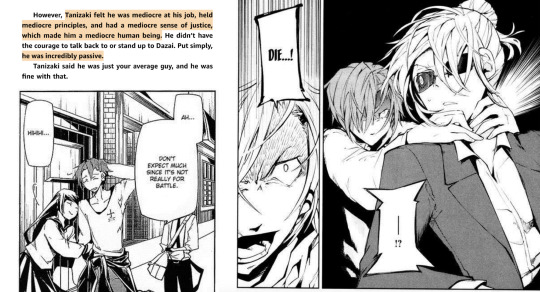
However, the theory that Tanizaki cannot be trusted to tell the truth about himself is supported by the real life counterparts’ use of this narrative device in his works. A journal article by The Columbia Companion to Modern East Asian Literature explains that “[Tanizaki-sensei’s stories] are often told by a personified and thus not necessarily reliable narrator,” which is especially evident in both Naomi (1925), a post-hoc account of the protagonist’s marriage, and The Key (1956), two juxtaposed diaries of a married couple.
Since Tanizaki-sensei tended to employ biased narrators in his stories, Tanizaki being an unreliable narrator of his own story would be a clever nod to his real life counterpart.
Moving on, the theory that Tanizaki may be lying about himself opens a world of possibilities regarding what the truth actually is. One popular fan theory is that Naomi is actually an illusory ability construct created by Tanizaki’s ability “Light Snow”.
Sculpting the Ideal Woman
Another recurring theme in Tanizaki-sensei’s works is a character’s desire to “shape” a woman into their vision for what that woman should be. This takes a variety of forms: in The Tattooer (1910), the protagonist “[desires] to create a masterpiece on the skin of a beautiful woman”, thus transforming her into a “real beauty”. In Aguri (1922) the protagonist dreams that “he would adorn [her] with jewels and silks. He would strip off that shapeless, unbecoming kimono... and then dress her in Western clothes”. The desire to make a woman more “Western” is also apparent with the protagonist Joji’s intent in Naomi (1925), the book that BSD Naomi is named after.
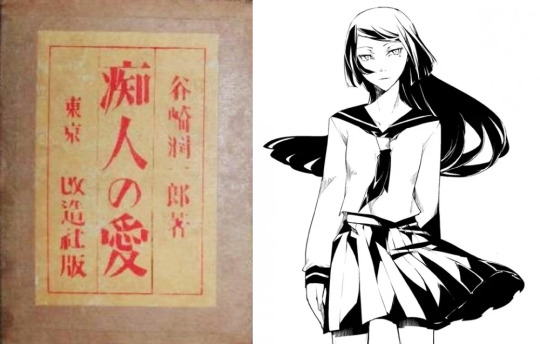
However, I must caution that BSD Naomi is actually quite different from how the character of Naomi is in the original novel; BSD Naomi is kinder to the people around her, and isn’t portrayed as selfish or manipulative. The two Naomis’ do share their penchant for mischief, and their bold, tomboyish personalities, as well as their surprising intelligence and aptitude for planning.
Back to the main topic: other BSD fans have pointed out that this theme of “making Naomi” in the novel supports the theory that BSD Naomi was created by Tanizaki’s ability. Considering that this pygmalion-like desire also appears in many other stories written by Tanizaki-sensei, the connection makes sense. Notably a role reversal between the “sculptor” and the “sculpture” always takes place in such stories.
Losing Control
In Tanizaki-sensei’s stories, female characters who are transformed to fit a man’s ideal are rarely subservient by the end of the narrative. Instead, the change oftentimes pushes them into a more dominant role, where they are the ones doing the controlling, rather than being controlled. In Naomi (1925), the protagonist narrates that “I forgot my innocent notion of "training" her: I was the one being dragged along, and by the time I realized what was happening, there was nothing I could do about it.” As the alternate title, A Fool’s Love, may suggest, by the end of the book Naomi has made a fool out of the protagonist, having “made careful plans and lured [him] on”, ultimately ending up in a position of power.
This could be indicative of Naomi’s own autonomy as an ability construct: we see her arguing with Tanizaki and defying his instruction, possessing talent and knowledge that Tanizaki does not have, and making decisions independent of Tanizaki’s will. For all intents and purposes, Naomi is no different than a human being.
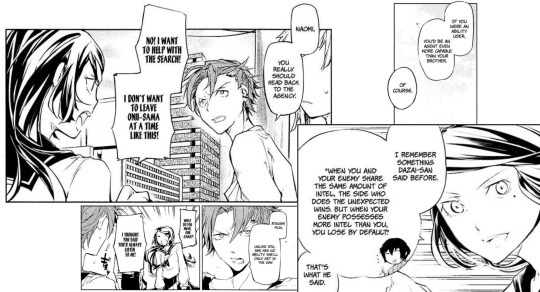
Of course, whether or not this theory will prove correct is a different matter. It should be noted that one variation of this theory speculates that Naomi did exist as a real person, but died in middle school. Unable to cope with the loss, Tanizaki unconsciously created an illusion in her image. This idea is reminiscent of A Portrait of Shunkin (1933), where it is said that in the years after Sasuke’s mistress and lover passed away, “he created a Shunkin quite remote from the actual woman, yet more and more vivid in his mind.” The character Sasuke was said to exaggerate his mistress’ talents to the point that his accounts of her were unreliable, and her passing contributed to his over imagination of her likeliness.
Secret Relationships
Another theory I have seen circulating the fandom is that Naomi and Tanizaki lied about their relationship, telling others that they are siblings in order to cover up their romance. In Naomi (1925), a similar ruse is hatched by the character Naomi, who goes behind her husband Joji’s back and sleeps with other men. Joji discovers this subterfuge from the character Hamada, who confesses, “I didn't know about you at all. Miss Naomi...said you were her cousin.” As such, Tanizaki and Naomi may similarly be lying about the nature of their relationship, which would be a nod to the original novel.
Of course, though I am partial to this theory, since I would be sad if Naomi turned out to be an illusion, I cannot with any confidence claim that it is more likely than the other theory I mentioned regarding her, or any other theories that might be circulating.
Return from the West
Moving on from theories involving Naomi, evidence that supports the theory that Tanizaki will change allegiances from the Armed Detective Agency to the Port Mafia can also be found with his real life counterpart. As I touched on a bit before, Tanizaki-sensei wrote about and was influenced by Western culture and traditions. However, after Tanizaki-sensei moved from Yokohama to the Kansai region in 1926, his fascination dwindled, and he completed works such as Some Prefer Nettles (1929), which “[presented] subtly and effectively the great transformation in Tanizaki's life from a worshiper of the West to a believer in the value of the Japanese heritage” as explained by Donald Keene in “Five Modern Japanese Novelists”.
One such work that compared Western and Japanese culture is “In Praise of Shadows” (1933), which associated shadows with traditional Japanese aesthetics, and light with the West. In the essay, he writes “If light is scarce then light is scarce; we will immerse ourselves in the darkness and there discover its own particular beauty.” In Bungou Stray Dogs, darkness and shadows are associated with the Port Mafia, while the light is associated with living morally upright. As such, Tanizaki-sensei’s shift from his fascination with the West (the light) to finding beauty in the darkness (Japanese traditions) could be paralleled in his fictional counterpart switching sides as well.
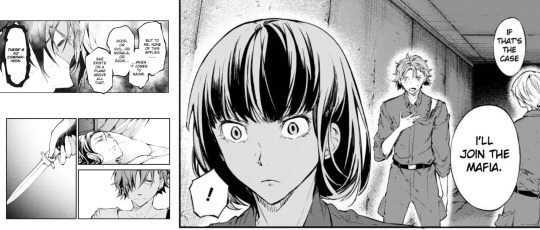
Moreover, although I am far from informed enough to speak confidently on this subject, I’d be amiss not to mention this meta written by bsd-bibliophile, which explains how the Port Mafia authors were faithful to the styles of traditional Japanese literature, whereas Armed Detective Agency authors were influenced by Western writing. Coincidentally, or perhaps intentionally, the comparison of Japanese versus Western traditions is the subject matter of “In Praise of Shadows” (1933), as I explained above; it would be a very clever reference to Tanizaki-sensei’s shifting interest if the theory that Tanizaki will switch sides ends up being correct.
In Conclusion
Despite knowing very little of Tanizaki’s backstory, and having limited on screen appearances of him in the story, much of what is established about Tanizaki can be traced back to his real life counterpart. We can also attempt to reverse engineer the character Tanizaki by making conjectures about his backstory and future character development based on what we know about Tanizaki-sensei. The theories that Naomi is an illusion, Tanizaki and Naomi are not real siblings, and that Tanizaki will switch sides are all supported by themes, motifs, and narratives that frequently appeared in Tanizaki-sensei’s writing. As such, I am very excited to see which theories will prove true, and how Asagiri-sensei will execute them in Bungou Stray Dogs going forward.
credits: bsd-bibliophile is a great resource for PDFs and ePubs of the works mentioned here, manga caps were scanned and translated by Easy Going Scans or Dazai Scans, highlighted passage in second visual is from the official Light Novel 3, left image in third visual is the first edition cover of Naomi novel
#bsd#bungou stray dogs#bsd naomi#bsd tanizaki#tanizaki junichirou#tanizaki naomi#bsd theory#bsd meta#bsd analysis#min i'll never write an essay of my own free will lu#clown emoji#i think i should get an extra lit credit just for writing this
367 notes
·
View notes
Text
🌃//Writeblr Intro//🌃
Hello! Welcome to my corner of the internet. I am Kae Luna. You can call me Kae or Luna. I am pretty new to Writeblr, so please bear with me.
╮ (. ❛ ᴗ ❛.) ╭
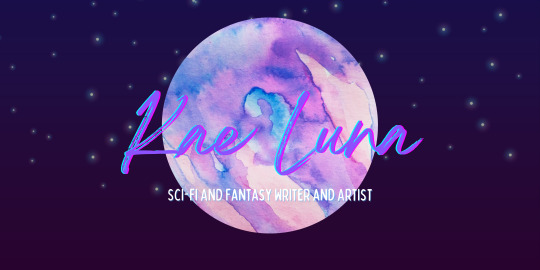
(Banner made with canva)
🌊About My Writing🌊
✨Genres: sci-fi, fantasy, supernatural, action, drama, psychological, LGBTQIA+
✨Subgenres: dystopian, cyberpunk, biopunk, solarpunk, post-apocalyptic
✨Common themes: diversity, anti-capitalism, female empowerment
Links🌐
Since I like both anime art and storytelling, I'm planning to make light novels. Some of them may be short stories, standalone novels, or series. :3 Going to put some of them on Wattpad and Tapas.
I try to balance unique settings with complex characters.
🌊About Me🌊
I've been writing and drawing since I was little. And before I could write, I would tell my mother my story and she'd write it down for me. I've always had a crazy imagination. When I was a tween, I got into anime and manga, so I learned how to draw in that art style.
I am 25, queer-romantic asexual, and feminine-presenting nonbinary. I identify as both a girl and a demi-boy. You can refer to me as she/her, he/him, or they/them. I don't mind. I'm also white and have ADHD, dyspraxia, anxiety, and depression that prevents me from getting a "real" job.
I'm pretty shy and anxious, but once you get to know me, I may say some weird stuff and dad jokes. I'm a big nerd and simp as well.
I am also a Vtuber, but made this alt identity since I didn't think my work would fit that persona.
🌊About My Blog🌊
Here I am going to post about my WIP stories and some of my art. I will also reblog others' art and writing. Many aesthetics, fandoms, and other stuff may be reblogged as well with tags if it inspires my work.
Here I hope to find more creators to connect with and find some epic creations. Feel free to message me if you'd like, though I am kinda shy. :3
I am okay with:
✨Asks
✨Tag games
✨DMs. I'm happy to make friends. :3
🌊My Likes & Favorites🌊
✨Aesthetics/genres: vaporwave, cyberpunk, pastel, eco punk, nature, grunge, post-apocalyptic, solarpunk, steampunk, fantasy, LGBTQIA2S+
✨Movies: Alita: Battle Angel, Ultraviolet, Aeon Flux, Spider-Man 2, Howl's Moving Castle, Black Panther, The Matrix
✨Shows: Doctor Who, Stranger Things, Umbrella Academy, The Witcher
✨Anime: Death Note, Attack on Titan, Jojo's Bizarre Adventure
✨Games: Skyrim, Baldur's Gate 3, The Sims 4, Minecraft, Fallout
✨Cartoons: Aeon Flux, Batman The Animated Series
🌊WIP(s)🌊
Ultra Drive - Intro Post | Directory Post
Links: Wattpad | Tapas (coming soon)
✨Genre(s): sci-fi, cyberpunk, action, drama, psychological, dystopian
✨CWs: government stuff, pandemic mention, gore probably at some point
When AlexiKa was a child, her world was changed forever when her family was forced to immigrate to the imperial city of Venicula after the Ebony Plague - caused by mysterious eumalyptus spores - infected her home town. Now a young adult, she works as a courier (and secretly an anti-corporation activist). When going on a delivery, she accidentally uncovers dark secrets and ends up infected with the same Ebony Plague that haunted her hometown as a child. But when she survives the illness and instead develops superhuman abilities, she joins a mutant resistance group to fight against the Veniculan Empire, the Gaia Corporation, and other mutants with immoral goals.
Adventures in Alsteria - Intro Post (coming soon!)
Links: N/A
✨Genre(s): fantasy, comedy, slice of life, action, adventure, LGBTQIA+
✨CWs: None ATM? Violence probably?
A trans femboy wood elf named Nel finds the homeland of his people - the rain forests of Falinor - and goes on an adventure to form a guild of adventurers! Still kind of in the vibes stage I guess, but I have some ideas formed for lore and characters. :> Something more cute and lighthearted for me to write in contrast to Ultra Drive.
Disclaimer: Unfortunately, I don't have much that I can share at the moment due to much of my writing being lost (school assignments or lost on old computers) or attached to other identities. I also had a looong writer's/art block.
#writeblr#writers on tumblr#writers of tumblr#cyberpunk#writeblr introduction#creative writing#writer#fantasy#sci fi#solarpunk#science fiction
33 notes
·
View notes
Text
Fire and Hemlock Readalong: Chapter 4
…in which there is a horse.
I always remember this being the chapter (during my first read through) where I was like “Oh Diana We’re Really In It Now.” After the unfriendliness of her home life, Mr. Lynn’s flat opens as a place of refuge where Polly is allowed to be her own person and where her imagination is treated as a perfectly valid and real thing (which of course it is, in Nowhere). The conversation between herself and Mr. Lynn also pretty well describes the Nowhere/Now-Here theme, though it still doesn’t entirely make conceptual sense unless you’re really focusing on it. Polly also describes Mr. Lynn as several different kinds of animals (tortoise, ostrich, orangutan, spider-monkey) which references the ballad (though perhaps in the most unromantic way possible lol).
The way DWJ describes the horse is incredible. Actually, everything she does with scene setting in this novel is incredible, but especially what she does with color: the golden light on the tree leaves, the orange light on Mr. Lynn’s glasses, the yellow-white of the horse. It recalls Her descriptions of Hunsdon House, a bit--her moments where magic breaks through are really richly developed, contrasted to places like Polly's school and street, which are just kind of in the background.
Mr. Lynn’s “Laurel taught me about horses” has always been something that feels really meaningful, though I’ve never exactly been able to connect it to anything, except merely that Laurel had instructed him in some way, which I suppose gives a little hint as to their relationship (that’s another thing I want to focus on this readaround—exactly what Laurel was to him, aside a weird first wife).
I know this is just me being the target audience for this book, but I find it so real how somehow Dad and Mr. Lynn are tied together in Polly’s mind even if her reasons for doing so are just circumstantial. Dad goes out, Mr. Lynn comes in. Another thing important here is naming: Ivy is always Ivy in this chapter, when she was both Ivy and Mum in the previous one. Clearly, her motherliness diminishes as her very flawed personhood comes to the fore, but Dad is here consistently Dad until we know better.
Spoilers below:
I notice here that when Tom describes Leslie as dark and thick-set, he’s wrong, but when Polly gives him a skull earring, that’s the part that comes true. So now I’m wondering to what extent Polly is the one possessing the truthful ability, not Tom, or not only Tom. He knows that storytelling is meaningful and yet it doesn't always work for him, the way it seems to for Polly. After all, he and Polly don't meet a giant in a grocery store, since that was his idea.
14 notes
·
View notes
Text
World building and theories of Engage
Amber's fashion
Amber's Japanese name can mean both 'amber' and 'umber'. Both names would fit into the Brodian theme of naming characters after stones and minerals. Amber is fossilised tree resin and as a gemstone it has the rare honour of being valuable the more inclusions found in the stone, especially if there is an insect or lizard inside. In Japanese amber is believed to be a conduit between the physical and spiritual realms as well as having the ability to possess the essence of ethereal creatures. This could be a reference to his interest in myth and legends as well as his attempts to battle mythical creatures. Umber is a natural earth pigment that can be ground to create dyes of warm colour tones that are quick drying.
Amber is the only Brodian unit whose initial class is as a mounted unit. This class could explain the minimal nature of his armour. He is only covered in armour in two hard wearing areas, one area is his lower legs and feet and the other area is his elbows. His sabatons are heeled and pointed in order to work in stirrups. To protect his body from the metal of his armour he has padding made of wool, likely alpaca since he comes from a hamlet infamous for the animal.
His colours of brown and red are the two most prominent colours in the clothing of Brodian characters. Brown could represent the earth while the red represents the red lion, fire and courage. Red is also worn so that blood does not show on a warrior's clothing. If you mix red and brown together you get maroon. In heraldry maroon means you are victorious and patient in battle.
Amber is the only Brodian to wear stripes. In the early part of the Middle Ages striped clothing was considered immoral, only prostitutes, outcasts, thieves, dancers and circus performers would adorn them. The stripes could reference his clown like antics, which Jade has used as inspiration for her novels. He acts eccentrically, wants to be a hero and goes on adventure, his personality is a grand performance.
Amber's casual fear mentions alpacas. Alpacas are not an animal found in medieval Scotland. In the present day there are alpaca farms but no wild herds. Why was the alpaca chosen as the creature to represent Amber? I think it is because it is like an exotic creature in a place they are unexpected to be. It is a reference to Amber's love of mythical creatures. Another reason the alpaca could have been chosen is simply because they are social, friendly and cute. It is clear that Amber's clothing is made from alpaca wool, possibly knitted by his family. Once again the clothing is in traditional Brodian shades.
4 notes
·
View notes
Note
Ooh, will you please analyze the scene between Patrick and Evelyn? Specifically where he breaks up with her? I would really love to hear your thoughts behind it. Why did he end things with her? He mentioned that he was feeling homicidal and nothing else could satisfy him anymore, but was that all there really was to it? Did they really love each other or was it all superficial? Please give me your thoughts queen!!
Hello, dear anon!💕
Well, referring to the book, I can say that Patrick and Evelyn never loved each other because they both had affairs and their engagement was pretty fake. But Patrick really tried to give their relationship a fresh start when they went to Tim's vacation house. I'd include a passage from the novel:
I really tried to make things work the weeks we were out there. Evelyn and I rode bicycles and jogged and played tennis. We talked about going to the south of France or to Scotland; we talked about driving through Germany and visiting unspoiled opera houses. We went windsurfing. We talked about only romantic things: the light on eastern Long Island, the moonrise in October over the hills of the Virginia hunt country. We took baths together in the big marble tubs. We had breakfast in bed, snuggling beneath cashmere blankets after I’d poured imported coffee from a Melior pot into Hermès cups. I woke her up with fresh flowers. I put notes in her Louis Vuitton carry bag before she left for her weekly facials in Manhattan. I bought her a puppy, a small black chow, which she named NutraSweet and fed dietetic chocolate trues to. I read long passages aloud from Doctor Zhivago and A Farewell to Arms (my favorite Hemingway). I rented movies in town that Price didn’t own, mostly comedies from the 1930s, and played them on one of the many VCRs, our favorite being Roman Holiday, which we watched twice. We listened to Frank Sinatra (only his 1950s period) and Nat King Cole’s After Midnight, which Tim had on CD. I bought her expensive lingerie, which sometimes she wore.
But nothing really worked, quote:
At night I’d place a faux-concrete and aluminum-wire sconce by Jerry Kott over Evelyn’s head and since she’d be so knocked out on Halcion she wouldn’t brush it off, and though I laughed at this, while the sconce rose evenly with her deep breathing, soon it made me sad and I stopped placing the sconce over Evelyn’s head.
Everything failed to subdue me. Soon everything seemed dull: another sunrise, the lives of heroes, falling in love, war, the discoveries people made about each other. The only thing that didn’t bore me, obviously enough, was how much money Tim Price made, and yet in its obviousness it did. There wasn’t a clear, identifiable emotion within me, except for greed and, possibly, total disgust. I had all the characteristics of a human being—flesh, blood, skin, hair—but my depersonalization was so intense, had gone so deep, that the normal ability to feel compassion had been eradicated, the victim of a slow, purposeful erasure. I was simply imitating reality, a rough resemblance of a human being, with only a dim corner of my mind functioning. Something horrible was happening and yet I couldn’t figure out why—I couldn’t put my finger on it. The only thing that calmed me was the satisfying sound of ice being dropped into a glass of J&B.
So, in my opinion, their connection was just a matter of the society they lived in, since Bateman was at the age when men were used to getting married, and Evelyn was just a suitable option for such a thing, but in the end, when he realized that his dark nature was taking over, he decided to break up with her, and that was only for the better.
I hope my "analysis" isn't too terrible, because I'm not good at that! Thanks for sending me your ask, it was a lot of fun writing all of this!
3 notes
·
View notes
Text

Okay so I finally got around to making Hitomi’s reference sheet (click for quality) so I can post it here. Also hi! I haven’t been “marketing” this blog a lot but basically my idea was to create a blog where Mob Psycho 100 fans can submit their mp100 ocs to a sort of “oc hub” and you can draw other people’s ocs if they’ve submitted them here too. You don’t have to be nearly as detailed as I was here for your own ref sheets, of course.
Anyway here’s Hitomi! I made her for a one-shot on my ao3 and then got attached to her and gave her more of a backstory. And then more backstory. And then a story involving her interacting with the Spirits and Such gang. And well...yeah it just keeps on going. My main is @birbliophile, in case you’re wondering.
BASIC INFORMATION:
Name: Furukawa Hitomi (she/her), lesbian
Age: 31 years old
Height: 168 cm
Esper Ability: Psychometry (receives visions of the past by touching objects)
Likes: Unusually flavored drinks (developed during her recovery from alcoholism. Also I mean like, pineapple-matcha-grape diet coke weird), bad romance novels, and collecting objects that have good memories attached
Dislikes: The taste of headache medicine, hot weather, and manipulative people (uh oh Reigen)
BACKSTORY:
Having awakened to her powers at a young age, Hitomi grew up constantly struggling with sensory overload from everything brushing against her bare skin, though she eventually developed techniques to isolate the sensations mostly in her hands. Feeling as if her parents treated her like a fragile doll and desperately wanting some measure of control over her life, her teen years were fraught with conflict and harmful coping mechanisms. As an adult she was recruited by the government to join a secret agency dealing with matters of the supernatural, and feels grateful to her job for helping her get on her feet...for the most part.
Employed as an intelligence agent and tracker, Hitomi often finds herself feeling as though the less ethical aspects of her job mean she has to keep herself isolated from her family and any potential friends, both to protect them and herself. After all, who wants to spend time with someone like her?
But when she meets a young telepath named Takenaka Momozou, suddenly Hitomi wonders if there might actually be room in her life for more than loneliness.
OC INTERACTION:
Feel free to draw Hitomi hanging out with your own OCs! Any platonic interactions are great, some ideas might be Hitomi and your ocs going to a cafe and trying out unusual beverages or comparing powers/lack of. You can also draw Hitomi fighting your OC a la Artfight if you want, in my mind she’s a bit more skilled than Reigen at combat.
Also, the blog is open for submissions! Based on an interest post I made, I know there’s a few people out there who might want to submit OCs to the blog, so don’t be shy! Check out the the guidelines in the FAQ if you’re interested :)
#mp100#mob psycho 100#mp100 oc#mob psycho 100 oc#mp100 ocs#furukawa hitomi#oc ref#mod bird#esper oc#espers#birbliophile#oc art#oc#info post#s3 spoilers
12 notes
·
View notes
Text
Do you know what time it is? Time for BSD OCs! This time, I'll be bringing something mentioned on my previous OC post of the Younger Siblinghood: the Shield Society!
The Shield Society is small, but very popular amongst the army, having even aided and been aided by the Hunting Dogs themselves. They take on medium level missions to high level missions, such as Lyubov Dostoievskaya herself. This post will have a different kind of description from the previous one, because I think this is better for me, thank you.
Yukio Mishima: Captain of the Shield Society
Aliases: Kimitake Hiraoka
Age: 17, but pretends he's 42
Ability: Deception of a Mask (Confessions of a Mask)
— Allows him to shape-shift into any other form he wants, being it other people or some small alteration of himself.
— Needs to have seen said form.
— Can copy the voice if heard or imagined it, depending on what form he takes.
— Cannot copy abilities, but can copy physical abilities, like strength and speed.
The young Yukio Mishima has been pretending to be an adult while wearing the military uniform of the Shield Society. He lives a double life, with struggles from both double identities and school. He's not simply pretending to be someone else, he's pretending to be his father, the previous captain of the unit, after he passed away when he was 12. Why? That's a long story to explain another time. The Shield Society knows about his true identity of a kid, but won't say or do anything, they might say that it's to not earn any weird comments or lose their honour, but it's more than that.
He's gay, and is kinda afraid of admitting it, but he has told his unit about it and they're okay with it. One of the members enjoyed that fact a little bit too much. He has been in a relationship with a teenage girl named Sonoko, related to another military unit that went to the same school as his, while being in love with a boy named Omi. Both were killed during his 14s.
He's very insecure of himself, tends to have silent breakdowns when alone and takes to easily admire those strict, tall, good-looking, strong and organised men with powerful physiques or abilities and leadership skills. Some examples of those are Ōchi Fukuchi, Suehiro Tecchō, Yukichi Fukuzawa and his most recent and top of the list, Doppo Kunikida. Changes his personality a lot based on his surroundings, such as the unit, school and with the ADA. Some of his current close friends are Hideaki Sena, Mari Mori, Jun'ichiro Tanizaki, Yasunari Kawabata and Marcel Proust.
• Yukio Mishima is the main core of the SS, which means lots of characters here we're chosen for a certain connection with him.
• Used his real life story to make his character, so for more reference, check his background! Just warning that there will be mentions of suicide by seppuku (beheading), so go with the warning and caution over that.
Hiromi Kawakami: Vice-captain of the Shield Society
Age: 36
Ability: Tread on a Snake (Novel with same name)
— Can turn into a giant snake
— Has fangs due to that
— Her bite will poison the bitten (but at will, no accidents)
— Her skin is very hard, bullets barely tickle
Hiromi Kawakami is considered one of the very few "pioneer Shield soldiers", since she was part of the unit multiple years before Yukio's father's death. Reached the vice-captain position easily and was a little annoyed at the situation of forced promotion that Yukio had to become captain (unwillingly). Tends to be very calm and collected, and some even say she's the mother of the unit.
Has rescued Mari back when she and her brother lost each other, becoming her mentor, as well as Yukio's (since he surely needed advice, he barely had much idea of what to do as the captain). Both quickly rose in power and strategy, and she's proud of them. Of lately, she has grown a small obsession on seeking Mieko Kawakami, the doctor of a small mafia and former singer that she had an acquaintance with, as visible whenever she's allowed to take over for Yukio during his "outside businesses".
• One of the only two that had no relation or connection whatsoever with RL Yukio Mishima.
• Real Life Mieko and Hiromi never met each other that I'm aware, I just wanted to use it because I found it sillily funny that they have the same surname and kanji for said surname. Not that it's impossible, just wanted to mess with it.
Mari Mori was explained on the previous post, but this is just to put depth of her role in the SS. Check the previous OC post to find her ability and more.
Mari Mori is far from a paragon of a soldier in terms of behaviour, but can be a great example of a soldier physique and physical abilities. Her speed is almost unmatchable, and that is with no ability. She's considered to be the best friend of the captain, mostly because she's the second youngest of the unit, losing to the captain himself only, who she's more than happy to share her male-male romance novels with, and confident on doing so, because he won't judge the love, but might judge the storyline written. She doesn't care, honestly, good criticism is accepted.
• Daughter of Ōgai Mori known for her male-male romances, which were read by Yukio Mishima.
Ruikō Kuroiwa: The biggest brain
Age: 26
Ability: Muzan (Novel with same name)
— Allows him to manifest two sides of his brain: Intuition and Logic
— Both look exactly like Kuroiwa, but Intuition is a sorta red vision of him while Logic is blue
— Intuition sometimes acts as reflex and instinct, mostly being listened to in combat rather than in investigation and interrogation, with Logic taking over that aspect. Intuition also helps him figure out things like poison on a cup or a hidden knife, while Logic helps him figure out locations of evidence
— His brain sides can be separated and stay invisible for others, with only Kuroiwa seeing them
— They can go away from Kuroiwa, but if they start going far, he will start to doze off, like sleeping with eyes open. If they're far enough, he might not react to his surroundings
Ruikō Kuroiwa is a young soldier that may not be considered one of the pioneer soldiers of the SS, due to him joining just a few years before the former captain died, but he's a brilliant and loved soldier known for both his great physical abilities and his great intelligence, that may not be close to Ranpo Edogawa or Yukito Ayatsuji (who he met and is having a small problem with), but is still very impressive.
A huge fan, and calls himself the number one, of Ranpo Edogawa. Would love to work alongside him and is not afraid to admit said admiration towards the man. He's considered to be a fanboy in terms of excessiveness, and some even theorise he started working as an investigative soldier because of him. Usually is the one after evidence of others and hidden documents, since his ability can separate and sneak into places and get stuff without being caught or noticed. Considered to be one of the greatest pieces of the unit, even if not the greatest in terms of combat.
He firstly made acquaintance with Natsuko Imamura, and then went ahead and met Yukito Ayatsuji and Mizuki Tsujimura. Later on, he met Ranpo, Poe and Mushitarō, as well as Agatha Christie and Yōko Ogawa, due to some incidents involving a group called the Falkner.
Kōbō Abe: The Arrester
Age: 24
Ability: The Woman in the Dunes (Novel with same name)
— Traps people in a house in the dunes
— Can either trap everyone inside the same room as his or the particular people he touches, depends on his wishes of who to trap
— The longer people stay in the house, the less they want to leave
— Abilities don't work in the house
Kōbō Abe started of as a pupil of Jun Ishikawa back in a private academy for ability users, and soon joined the military unit Shield Society after catching the attention of the previous captain, Azusa Mishima. He tried his best to avoid a life in the battlefield, but thanks to his father and the previous SS captain, it was all in vain.
A man who tends to play with memories of himself and others (good or bad, anything to his advantage), Abe is often in the front line, usually side by side with Mishima or Kuroiwa, whose abilities are not very fit for combat. Can be considered ruthless and cruel, but just to those he views as an opponent and/or threat. Is not afraid of being honest, and that led to a few beefs with other soldiers from other units and some other people. Abe is the person that understands Mishima the most, since both ended up in positions that neither really wanted to be in.
• Has a connection to Yukio Mishima, and even participated of a protest with him, Jun Ishikawa and Yasunari Kawabata.
#bsd#bungou stray dogs#bsd oc#bsd ocs#alternate universe#alternate timeline#bsd manga#bsd anime#yukio mishima#hiromi kawakami#mari mori#ruikō kuroiwa#ruiko kuroiwa#kōbō abe#kobo abe#fanon#fanmade
2 notes
·
View notes
Text

FULL DOCUMENTION OF BEYOND BIRTHDAY: one large post containing a breakdown for beyond birthday // * brief mentions of violence, death, and suicide.
please note that i only consider the novel, the manga, and the anime for sources and influences. the manga timeline is the main source i rely on with the novel being secondary. i do not consider any live action interpretations, including plays, so all information below is based on the three sources listed. all quoted content is from the translation of the LABB novel. i sometimes reference the DS games, but not often (if at all tbh).
NAME: redacted from records; officially born ‘bellamy bishop’. known only to himself, although was potentially revealed by B to the first child of wammy house “A”
TITLE: second child of wammy house, proposed successor to L, “backup”
ALIASES: B, BB*, beyond birthday**, rue ryuzaki**
** both beyond birthday and rue ryuzaki are self-given aliases, and are not known by wammy house. beyond birthday and rue ryuzaki are not associated with “B.”
DOB: oct 30 1983**
** making him 8 by the time he enters wammy house in roughly 1991 **
DOD: 01/21/04**
** making him 20 when he is killed by kira **
his DOB is based on his DOD, the vague description misora gives about his features (and it is revealed he wears heavy makeup when with her)
GENDER: cis-male
PRONOUNS: he/him/his
SEXUALITY: pansexual, demiromantic
HEIGHT: 6′ (182cm)
WEIGHT: fluctuates, generally on the thinner side (L is 110lbs or 50kg)
HAIR COLOR: naturally black, has been dyed
EYE COLOR: black, hued red in certain lights, and is blamed on partial albinism
FAMILY: father (deceased, attacked by thugs), mother (deceased, train crash), other family unknown and/or presumed deceased
ETHNICITY: japanese, vietnamese, english
DEFINING FEATURES: long limbs and features, gangly, spider-like, scruffy face, bulging eyes, dark circles, disheveled exterior.**
** “Natural black hair. A plain shirt, faded jeans. He was a young man, with dark lines under his wide, bulging eyes. Thin, and apparently fairly tall, but his back was curved, leaving his gaze two heads lower than Misora’s so he appeared to be looking up at her.“ and “[ ... ] well—he had always disguised himself with heavy makeup while he was with Misora [ ... ] ” **
we can assume his skin tone is likely a lighter tan towards a paler complexion based on his lifestyle, but made himself paler with makeup to deceive misora. he also likely added the extra shadows and dark lines beneath his eyes.
ABILITIES: shinigami eyes from birth (”eye born”), though he cannot see the time of his own death
IQ: 274
LANGUAGES: english, vietnamese, japanese, korean, italian, latin, thai, and others
LABB CASE YEAR: summer of 2002
AGE DURING CASE: 18, almost 19
LABB NOVEL TIMELINE:
FROM MAY 2002 - JULY 2002: L looks for B after B abandons Wammy House post-A’s suicide.
JULY 22 2002: LAPD receives an impossible to solve crossword puzzle.
1ST MURDER: July 31 2002, drugged and strangled, cuts on the chest post mortem .. roman numerals.
2ND MURDER: 4 days later, August 4, 2002, drugged and beaten to death (head), eyes poked out and crushed post mortem.
3RD MURDER: 9 days later, August 13, 2002, drugged and stabbed, died of massive hemorrhaging and blood loss.
AUGUST 14, 2002: Naomi and L make contact.
AUGUST 15, 2002: Naomi begins working for L.
AUGUST 15, 2002: Naomi and ‘Rue Ryuzaki’ make contact at the first crime scene.
AUGUST 16, 2002: L confirms to Naomi of Ryuzaki’s employment as hired by the victims’ families as a private detective.
AUGUST 16TH 2002: Beyond Birthday attacks Naomi in an alleyway on her way to the second crime scene. L tells Naomi that the killer is ‘B’.
AUGUST 16, 2002: Naomi investigates the second crime scene with Ryuzaki.
AUGUST 19, 2002: Naomi Investigates the third crime scene with Ryuzaki.
AUGUST 20, 2002: Naomi stays in a hotel in West LA with preparations to arrive in the evening in Pasadena, CA by August 21st.
AUGUST 22, 2002: Naomi poses as Blackberry Brown in Condo 1313, preparing to catch the killer; 9 Floors Below, Ryuzaki poses as Bluesharp Babysplit in Condo 404.
4TH MURDER: August 22, 2002. unsuccessful suicide by fire as the intended victim to be Rue Ryuzaki / Beyond Birthday in attempts to create ‘the perfect crime’ / ‘an unsolvable case’ ***
AUGUST 23, 2002: BB begins recovery for severe third degree burns in the hospital; after months of recovery and surgery, he is sent to jail.
(LATE) ??, 2002 - ??, 2003: Mello of Wammy House meets with Beyond Birthday.
JANUARY 21, 2004: Kira kills Beyond Birthday in jail using the Death Note. Cause of death is specified as a heart attack.
*** “Immolation. Burning to death.
“He had chosen himself to be the fourth victim. Beyond Birthday, the final B.B. That Rue Ryuzaki was a fake name did not even require L’s resources—Misora was an FBI agent, and could find that out for herself quickly, and if she dug a little deeper would be able to find out that his real name was Beyond Birthday. B.B.
Naturally, his face and fingerprints would burn as well — he had always disguised himself with heavy makeup while he was with Misora, and he had never left a picture behind, so even if someone directly affiliated with Wammy’s House inspected the body, they would have no idea that Rue Ryuzaki/Beyond Birthday was B from Wammy’s House. HE HAD LEFT NOTHING TO CONNECT BEYOND BIRTHDAY TO B. He had no intention of hiding his own identity (he wanted them to find out he was Beyond Birthday, to find out he was another B.B.), but he had to hide that he was B from Wammy’s House.”
[ … ]
A PROBLEM WITH NO SOLUTION COULD ONLY HAVE ONE ANSWER—THAT IT COULD NOT BE SOLVED. But that answer conflicted with the fairness displayed in the first three murders. Which tied their hands. Unable to find something that wasn’t there, L would have to continue searching for B—who no longer existed. The metaphor of the gradually decreasing Wara Ningyo established from the beginning that there would be only four victims, so the lack of further murders would not lead to the conclusion that the killer had passed away. L would be left chasing after the mirage of the deceased B. L would be forever followed by the mirage of the deceased B. L WOULD SPEND THE REST OF HIS LIFE TREMBLING IN FEAR OF B’S SHADOW.”
[KNOWN] VICTIMS:
Believe Bridesmaid: 44 years old, male, deceased
Quarter Queen: 13 years old, female, deceased
Backyard Bottomslash: 26, female, deceased
PERSONALITY AND ALIAS DISTINCTIONS: there are four main identities that come from [my interpretation of] B — “B” of wammy house, beyond birthday (or BB), and rue ryuzaki (RR or LL).
bellamy bishop — who he was born as, with this name being known only to himself. he has completely disassociated with this identity. the only people that know him as bellamy are all deceased, A included.
“B” of wammy house — who he became upon entering wammy house. the most “true” version of himself.
beyond birthday — as mentioned above, no one at wammy’s knows him as beyond birthday or “B.B.” it is a self-taken identity, and one that he plans to use as the fourth “victim” to the “killer” in the LABB case. this the identity he wanted his corpse to be ultimately known as, as well as who he is referred to by mello via the narrative.
rue ryuzaki** — another unknown identity to wammy house, the man that misora naomi saw on fire, and the alias eventually taken by L in death note’s main timeline / post LABB. this is B’s detective persona, one that he uses primarily when contacting the families of the victims, as well as the alias he interacts with misora under throughout the novel. rue ryuzaki is also a social persona B has been creating for a while, and finally gets more use from when he leaves wammy house in may 2002. B’s version of ryuzaki is based on a lot of the personality B imagines L to have, basically making ryuzaki a projection, or imitation, of L.
** “B approached Naomi Misora, calling himself Rue Ryuzaki. Rue Ryuzaki – L.L. For anyone from Wammy’s House, there could be no higher goal than identifying yourself with that letter — and Beyond Birthday seized this case as his chance. Even Naomi Misora knew what had happened to detectives falsely identifying themselves as L, and B was from Wammy’s House, so he knew better than anyone so this choice suggests the strength of his decision. He never once intended to survive, he had made up his mind. He was ready.” **
[ ... ]
“According to L’s investigation, a detective named Rue Ryuzaki had actually been hired by Believe Bridesmaid’s parents—and not only them, but relatives of the second victim, Quarter Queen, and the third victim, Backyard Bottomslash, had asked Ryuzaki to investigate the matter as well.”
regarding B, beyond birthday, and rue ryuzaki — these are three entirely separate identities. we do not see much of “B” in the novel, just beyond birthday and ryuzaki, and they are very different. the most connecting physical factor is their natural black hair, but “ryuzaki” is an identity that is worn with heavy makeup as a disguise. B even brushes his hair when getting ready as ryuzaki, which is counterproductive in itself; L does not brush his hair.
we can assume the brief bits of “beyond birthday” are actually “B.” beyond birthday and B do not necessarily have separate personalities, just individual “identities.”
it’s a bit complicated, as B starting calling himself beyond birthday at an unspecified point in time, but never revealed that alias to anyone (that we know of). it is never directly said he started using the beyond birthday alias before or after wammy house, just that he used it at all, and that it was self-given.
** “He had those eyes before he was born, which is why he called himself Beyond Birthday. Which is why a child as strange as he, was taken in by our home, sweet home—Wammy’s House.
He was B.
The second child in Wammy’s House.” **
so, regardless of when it started, beyond birthday is an internal alias; it is the start of “B.B.”
it was B’s intention that beyond birthday would eventually become “the fourth victim” in the case, while “B” just disappeared from wammy house. there is no intent to connect beyond birthday and B from wammy house together.
“if she [Misora] dug a little deeper would be able to find out that his real name was Beyond Birthday. B.B.”
this means that B left record of a “beyond birthday” to be found on purpose, as it was stated that he chose rue ryuzaki to be intentionally discovered as a fake almost immediately to lead misora away from the identity of rue ryuzaki towards the identity of beyond birthday. it is unclear what “records” he leaves for her to find this “beyond birthday.”
so, while there are four total identities, there are two key personalities being displayed in the narrative of the novel: ryuzaki and beyond birthday (or, ”B”).
we know now that B and beyond birthday are basically the same. beyond birthday is written as more cruel, jaded, and prone to speaking incoherently, as well as to himself. he gives himself instructions, specifically how he should laugh. as ryuzaki, he acts more composed, albeit eccentric (the way he believes L acts), and somewhat energetic. while "ryuzaki” speaks strangely, exhibits peculiar mannerisms, and seems to lack proper social etiquette, he is far more “personable” than beyond birthday.
in his youth, i believe B tried to emulate L more often than not, while also exhibiting his own strange mannerisms. this is a technical blend of his own personality in conjunction with what will eventually become the ryuzaki personality.
he was also known to act strangely in his years at wammy house, frightening the other children. he was intelligent, clever, and highly gifted, but was also erratic, unpredictable, and aloof to a fault. he often was hunched, barefooted, and displayed other tendencies rumored to habited by L. i believe he was always eccentric, described as “brilliant and deviant” in the novel, and was always prone to a draw towards death, as well as the occult. by the time we actually see B, or beyond birthday, in the novel, we can tell he is unable to be “saved.”
A’s suicide is what drove B to finally “lose it.” he was already naturally prone towards villainy. from birth, B saw death / he saw red, and A “leaving him” was the final straw.
NOTATIONS (RUE RYUZAKI, L, WAMMY HOUSE, ETC):
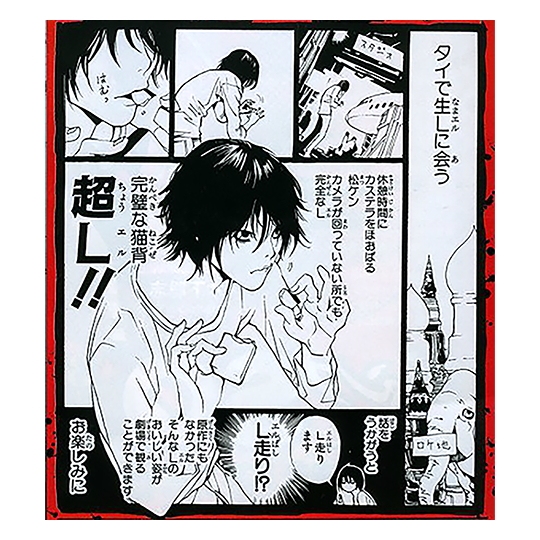
i think the above image represent the aesthetic of L that B tries to emulate the most when acting as ryuzaki, the hair is (mostly) natural, which is why this look is fitting, as it’s more flat than L’s usual look. this version of L is not as ‘stylized’ as we see later. it’s more akin to very early L, before ohba had explicit directive instead of a concept. B’s ryuzaki is flat and messy, more natural looking especially in the hair. he hunches like L, though doesn’t really understand L’s true fascination with candy and desserts, so seems to imitate that habit poorly (the jam). they share a similar physicality, though B’s weight fluctuates more than L’s given his fluctuating living conditions pre /post wammy house.
given their age difference, B and L were in wammy house at the same time. B is four years younger than L.
L says,
“I have nothing to do with him. To be completely accurate, I do not even know B. He is simply someone I am aware of. But none of this affects my judgment. Certainly, I was interested in this case, and began to investigate it because I knew who the killer was. But that did not alter the way I investigated it, or the manner in which my investigation proceeded. Naomi Misora, I cannot overlook evil. I cannot forgive it. It does not matter if I know the person who commits evil or not. I am only interested in justice.”
despite the text saying they never in met person, there’s going to be some major canon divergence in my interpretation while using the text as a backbone.
the timelines of LABB and DN coincide without issue, but some of the canonical details versus the fanon details of the novel conflict, which is where i am left to make adjustments. i bend to the DN canon before the LABB canon.
post his leaving, L might have visited and observed, or spoke via voice-chat** – but L also does lie a lot, or will at least stretch the truth, and has a habit of forgetting people easily (he “forgets” misora when during her arc in death note). just because L says he does not know B does not mean that B does not know (remember) L. it could be argued that L either a) does not remember seeing, meeting, and/or interacting with B before the LABB case, or, b) is lying. both seem plausible.
** we know he at least does this, as we see him conversing with near’s generation of wammy children canonically in death note. we can assume he might have done this post-leaving the wammy house for B’s generation, too. **
from the beginning, L was extremely isolated from the other children before his departure from wammy house with watari, so B could have potentially seen or spoken with L in person before L left. this would mean he met L before L became the great detective, so is emulating L from memory, as well as an early version of L.
based on L’s appearance when he entered the wammy house, as well as the novel saying that watari met L when he was eight, it’s safe to say definitively that L came to wammy’s before B, and was there for years before B was “enrolled.” i have B as eight when he enters the wammy house, which would make L twelve. by this time, L was already functioning within wammy’s, but was independent of the other wammy orphans, primarily locked away in his room.
L is sixteen when he leaves with watari, making B twelve.
this would be when B goes into the running with A (and C) to become the first “wammy children” that we know of. before this, they (A, B, C, etc) were likely going by whatever names or aliases they preferred. B came in without ever having his name revealed to watari or roger in the first place, and it is unknown what the other children went by before becoming “lettered.”
while B is known as the “second child in wammy house” in the novel, wammy house was a running establishment prior to A and B’s arrivals, meaning that being titled this is more applicable to the L succession program.
A and B are the first children of the “L project.” we know that there are many children in wammy house, as well as other orphanages run by watari. wammy house seems to be more focused on particularly gifted children, or that is where the most gifted tend to be located and/or relocated depending on their situation.
it can be agreed that B did a decent job emulating L, so it’s more likely than not they have interacted in some manner, and that L’s dismissal of B (only knowing of him) is either L lying or misremembering. it is likely B is also copying what he has heard about L, adding that into his characterization of him.
THE (A)LTERNATE + THE (B)ACKUP: “The first child, A, was unable to handle the pressure of living up to L and took his own life, and the second child, Beyond Birthday, was brilliant and deviant.” A commits suicide by may of 2002. B, who was eighteen, was already planning on leaving wammy house, hopefully with A. after A’s death, B leaves wammy house, which prompts L to look for him. this is right before the LABB book begins. they were the “first children” of wammy house.
A was B’s closest connection, and his death is the reason that B finally left, enacting his plan. as mentioned above, A’s suicide is B’s breaking point.
it is unclear if B was planning the LABB murder cases (the unsolvable case) / to be L’s greatest foil prior A’s death. it’s even more unclear if B would have still enacted this plan at all, were he planning it, should A have lived. B is not just a backup to L, but is also a backup to A (the “alternate” or “alternative”). whether they were close before the successor program, they were after. while B insists that B will top L, A is the only one that can top B. symbolically, A is the alpha, while B is the beta. i am affiliated with yeonban’s A, and reference him often in threads. i suggest reading A’s document if you want to learn more about him!
OTHER LETTERS: we can assume that A, B, and even C were all in one generation. other than that, the actual “generations” aren’t completely consistent to the alphabet, as (m)ello and (n)ear were the most recent candidates, the two that L had no chosen between before death. there is a potential wammy child “J” in one of the DS games, and you can read about him here.
“If I had space left over I had intended to carry right on into the other two stories I heard from L: the story of the detective war between the three greatest detectives, all solving that infamous bio-terror case, with guest appearances by the last of the alphabet, the first X** to the first Z** from Wammy’s House; and the story of how the world’s greatest inventor, Quillish Wammy, aka Watari, had first met L, then about eight years old—the case that gave birth to the century’s greatest detective, The Winchester Mad Bombings that occurred just after the third World War**.”
it is interesting that they are described as “the first” x, y, and z. this could be a translation thing, but it could also infer that letters are replaceable, and subsequently we have seen replacements via near and mello.
we can infer that the A and B we know are the first of their letters, as well as L, and potentially C(?). we do not see replacements in death note for these letters, and by DN canon alone, we are left to assume that mello and near are the first “M” and “N” in wammy house. but this could be entirely false.
by the time we see them, they could be the second generation of letters, having gone through another A, B, C, all the way to M and N. it could stop at N, or it could go on to the end of the alphabet. we just do not know. it’s also interesting to note that characters like near, mello, matt, and linda all have aliases that are names, not letters, and that particularly near and mello are named by not just aligning the first names of their aliases to their birth names, but also their places in the wammy alphabet of succession.
it also leaves questions for characters like matt and linda, as matt specifically is considered still to be the third in line, despite sharing a named alias that begins with the same letter as mello, with mello being the one known as “M.”
by the naming convention alone, as well as seeing that the heirs of L are at least encouraged to play should they want to, it’s clear that some structural differences have been made to the heir program. this could infer that potentially the entire first generation of lettered children “failed” for various reasons, most all ending in death.
this all strongly leads me to believe that near, matt, mello, and linda are all part of a second generation of L’s heirs in the timeline, though linda does not seem to be in line as a successor, instead showing that there are still other children at wammy house not affiliated with the program, albeit brilliant themselves.
** i’m not even going into the third world war mentioned in the novel here in this post. **
LIVING CONDITIONS: post-wammy house, B has no singular address. it is noted that he has many lairs specifically across the united states, but also throughout the world. i headcanon that he was establishing headquarters before leaving wammy house.
MISC HC // * READING: B will read books over and over again, memorizing every line, every word, every letter until he can recite the page number, line, the book backwards if you wanted. he reads books at least four times, but never more than thirteen. this is not something A has to do. B has a photographic memory like many of the wammy children, and finds himself burdened by the constant names and dates he sees with his special eyes. by this logic, he also can usually tell who and who will not be the next L based on their dates of death, specifically for children like A, matt, or mello.
more likely tba

#/ * SCARLET LETTER ( BEYOND BIRTHDAY )#/ * HEADCANON#ill likely edit this tomorrow morning to give my brain a break but#here it finally is#it's very long and is primarily a resource for me but i think it's helpful in converging LABB and DN
10 notes
·
View notes
Text
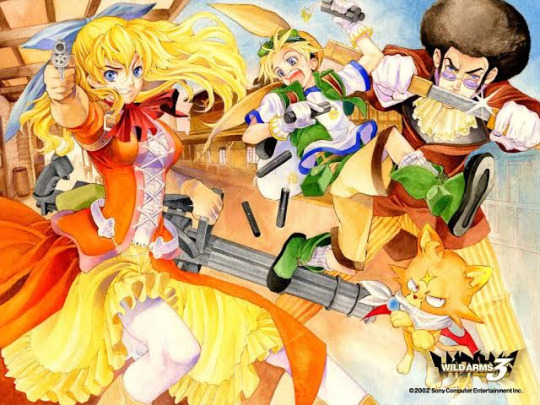
I feel like i don't need to explain it but the Schroedinger family is named after Erwin Schrödinger
Shady specifically is of course a reference to the "Schrödinger's cat" paradox, a kind of thought experiment/metaphor for illustrating the more conventionally nonsensical seeming qualities of quantum physics. Shady is just literally a cat who was in a box, and also has some dualistic qualities like his use of both fire and ice magic.
And Maya is of course even in-world a throwback to Calamity Jane Maxwell from the first game, having applied her ability to materialize information she reads in books to the adventure novel "Disaster Girl of the Wasteland" she both she and Virginia are fans of --incidentally the Japanese [荒野の災厄娘] would be more readily translated as "(The) Wasteland's Calamity Daughter"/"Calamity Girl of the Wasteland" so it was likely meant to be a much more direct reference to Calamity Jane. (Virginia herself of course also bears the Maxwell family name and may well be a distant descendent of Jane's if the two games' Filgaias are in fact part of one contiguous history.)
Todd Dukakis is a sort of throwback to both McDullen/Magdalen Harts as well as Jack Vanburance from the original Wild Arms. He's Maya's butler like McDullen was to Jane, but also uses Jack's attacks --Psycho Crack, Meteor Drive, Divide Shot & Heal Blade/Factor-- as well as Black Fenrir, harkening back to the Fenril[sic] Knights.
No idea about Alfred, actually... He's a kid with bombs who is shown to be good with tech, so I guess sort of a parallel to Rudy? It's actually really weird that he's got a much less distinctive gimmick when all the others are very strongly designed around their thing.
Their team attack "Wild Bunch" is a reference to either the 1969 Sam Peckinpah film, The Wild Bunch, or the real world wild west gang led by Butch Cassidy.
3 notes
·
View notes
Text
Blog post #6: Memory and Survival in Rivers Solomon’s The Deep
Having been consistently fascinated by works of Afrofuturism, I sought out more only to discover The Deep, an Afrofuturist novel by Rivers Solomon. The novel is based on a song also entitled The Deep by the group Clipping. Rivers Solomon took the story embedded within this song and turned it into a truly remarkable novel. This in itself felt meaningful to me, considering how many centuries of historical and cultural memories of African Americans followed the same trajectory—being passed down in song, before eventually being recorded and written down.
Both the song and the novel tell the story of mermaids who are the descendants of African women who were pregnant, enslaved, and thrown overboard where they gave birth to babies who breathed the water, as they did in the womb, who adjusted to their new surroundings and made a beautiful life in the deep waters of the ocean in their society of Wajinru. After so much time, though, that history has been forgotten by everyone, well, everyone except for Yetu—she alone has been chosen to be the new historian, the one charged with remembering on behalf of everyone. The memories, you see, are just too traumatic, too hard and ugly, and so survival (they thought) required forgetting. Yetu thinks differently, though. She believes that survival of her people requires them to remember, to reclaim their memories (traumatic as they are) because that is the only way to reclaim their identities.
This story captures so much of the African American experience in so many layered ways. First, the obvious ones. The Mer people live in the deep ocean, separated from the world above water—this, to me, seemed to be a metaphor for the marginalization of African Americans, specifically in terms of residential segregation and geographic isolation in dense urban areas. Then there is the idea of adaptation, survival, and the Mer peoples’ ability to adapt to a new environment mirrors African Americans' adaptability to the white dominated culture they were thrown into and not just survived, but thrived within. Most importantly, though, is the role of cultural memory and the question of whether forgetting or remembering is the best tactic for survival, and in this book it seems Rivers Solomon is suggesting that African Americans (or all descendants of enslaved peoples, not just those in the U.S. alone) have been ignoring the most difficult parts of their history when, in reality, an awakening to selfhood and identity requires knowing the past, even the ugliest and hardest parts of it. The historian before Yetu, named Zoti, explained why there is only one historian, only one among the wajinru tasked with remembering the past: “I fear if they know the truth of everything, they will not be able to carry on, or they’ll swim to the surface to learn things for themselves that I do not want them to learn” (p. 63). However, as Yetu’s experience shows us, the burden of remembering is too much for just one person alone to bear—and it is far healthier for Yetu herself and for the entire community when they all remember collectively and, in that memory, they find peace. This book is about inequality and the legacy of colonialism, but it is also about how (or, whether) we talk about, recognize, and cope with that legacy in the present day.
Reference:
Solomon, Rivers, Daveed Diggs, William Hutson, and Jonathan Snipes. 2019. The Deep. New York: Hodder & Stoughton.
0 notes
Text
Blog Post 2
apanese horror in the 1990s and 2000s consists of many different movies that span across a wide array of topics. However, it can be argued that the movie Ring (1998) is the most important and influential movie to come out of this time and genre for many reasons. Some of these reasons include that it was remade in Hollywood as The Ring (2002) and not only that but was by far the most successful out of any Japanese horror Hollywood remakes. Another reason showcasing its importance and influence was it changed the process of horror in Western culture at a time when the slasher sub-genre was dominating Hollywood horror. This film is far different from these slasher films because it is less about blood and gore to scare the viewer, but enlists the human fear of death and, with the help of suspense and building up scenes, creates fear from something as little as a phone ringing.

The movie Ring was released in 1998 and directed by Hideo Nakata. This film was based on the novel by Koji Suzuki in which the story revolves around a cursed videotape. In both the book and film, this videotape causes anyone who watches it to die seven days later. The film begins with two high schoolers who discuss this urban legend of a videotape that causes its viewers to die seven days after receiving a haunting phone call. One of the high schoolers admits that she watched a strange videotape with friends and received a phone call afterward. The now dead high schooler’s aunt, Reiko Asakawa who is also a reporter, attends her funeral and learns that three of her friends who watched the tape with her also died at the same time. While investigating the death of these high schoolers Reiko watches the tape herself and must figure out how to break this curse within the seven days she has remaining.
A scene I chose to analyze from the film is when Ryūji Takayama, Reiko's psychic ex-husband whom she recruited to help her investigate the curse after she watched the video, is killed by the curse himself. This scene is important because they both previously believed that they had broken the curse by freeing Sadako’s remains from the well she was trapped in. Sadako is the daughter of a woman by the name of Shizuko who has psychic abilities. Sadako was trapped inside this well by a doctor, who was researching ESP and therefore Shizuko after she killed a reporter who denounced her mother’s abilities. The videotape had been holding her anger that she projected from the well where she lived for seven days before passing away. This scene is important because it shows what happens to those watching the tape firsthand and was when Reiko realized the real way to survive the curse. She realized that showing another person a copy of the tape passes the curse onto them, as she had done to Ryūji without realizing it. This scene is very different from what was popular in the West at the time, with slasher films dominating the horror genre. It was a slow and suspenseful action that led to his death and there was no blood and gore. Even with the lack of gore, this scene can still be seen as terrifying, not knowing what is going to happen next.
https://www.youtube.com/watch?v=G3kiwpnO7RU

Looking at articles shows just how influential this movie was at the time. This movie created a new template for modern Asian horror. The movie's international success created a global fascination with the sub-genre of horror, J-horror. This set the scene for many other Japanese horror movies to grow in popularity. This is supported by the article written by Nikki Baughan where Nikki states that the film Ring “helped kick-start a boom in Asian horror that, along with growing international appreciation for anime, helped change the fortunes of a Japanese industry that had been in decline since its peak in the 1960s” (Baughan, 2015).
References
Baughan, N. (2015, December 21). “ring” (1998). Screen. https://www.screendaily.com/ring-1998/5098302.article
Guardian News and Media. (2008, October 31). Ring Review – the original and best: A genuinely Scary Movie. The Guardian. https://www.theguardian.com/film/2008/oct/31/ring
YouTube. (2016, September 25). Ringu (JAP) | TV scene (ending). YouTube. https://www.youtube.com/watch?v=G3kiwpnO7RU
0 notes
Text
'“We have all been Tom Ripley ,” said director Anthony Minghella in an essay published in The Guardian a few days before The Talented Mr. Ripley (1999), his adaptation of the novel of the same name by Patricia Highsmith, competed at the Oscars – where, despite coming in with five nominations, including Adapted Screenplay and Supporting Actor for Jude Law , it ended up coming up empty. Minghella was referring to one of the qualities that have ended up turning the character, played in his film by Matt Damon , into a dark and fascinating icon for several generations of readers: his ability to draw the reader, or the viewer, into the pocket from the moment it enters the scene. According to the filmmaker , “ his actions are an extreme response to emotions that we all recognize : the feeling that there is a better life and that it is being lived by another person in another place. Someone who does not see himself trapped within that empty existence in which the rest of us find ourselves. It is one of the traits that make us human.”
Twenty-five years after The Talented Mr. Ripley , Steven Zaillian – screenwriter of Moneyball (2011) or The Irishman (2019), as well as the person responsible for the also excellent The Night Of (2016) – returns to the scene of the crime with Ripley , an eight-episode miniseries that adapts Highsmith in rigorous (and evocative) black and white. To achieve this, he has had none other than Andrew Scott , whom we have just seen shining in the excellent Unknowns (Andrew Haigh, 2023), as his main collaborator, which seems to us, a priori, to be a success: after all , his James Moriarty in Sherlock (2010-2017) already showed some of the essential characteristics of Tom Ripley, such as his recalcitrant hedonism or his conception of life and, above all, interpersonal relationships as a great game of chess. There is, however, an essential difference between the two. While Scott's Moriarty was the living image of what we could understand as Dionysian, Ripley spends most of his time posing as an Apollonian subject. His pleasure principle is so subject to appearances that, deep down, we could speak of the patron saint of Epicureanism in crime fiction : although it is true that he always acts motivated by the search for personal benefit, his iron system of values and His worldview (purely materialist) provides him with a disguise of respectability. We know that a monster hides behind that mask, but we are not sure to what extent Tom Ripley has become so accustomed to it that, in the end, it has ended up being his true personality.
The cast of the miniseries also includes names such as Dakota Fanning, Johnny Flynn or, attention, John Malkovich, who played Tom himself in Ripley's Game (Liliana Cavani, 2002), based on the third novel that Highsmith dedicated to him. most disturbing of all his characters. Wim Wenders had already been inspired by it to create The American Friend (1977), an interesting exercise in neo-noir with Dennis Hopper and Bruno Ganz as protagonists, but none of these punctual and self-contained adaptations are comparable to the pleasure of reading the works in order. five installments that make up the Ripley Cycle: from 1955, the year in which The Talent... was published , until 1991, when Ripley in Danger appears , Patricia Highsmith made us participate in the non-evolution of a perfect psychopath in whom, however, no we can avoid glimpsing something of ourselves. The writer never put any emphasis on the moral substratum of her plots, allowing Ripley's clinical and dispassionate personality to also cloud her prose. Both she and he become strong in ambiguity and gray areas, especially with regard to the sexual component that, in some way, bubbles under each and every one of her books like volcanic magma, but without ever reaching become explicit.
There are those who consider that Alain Delon nailed the platonic ideal of Tom Ripley in Full Sun ( René Clément , 1960), freely inspired by The Talented… , since it was not in vain that it was the film that transformed him into a star. Maybe, but Ripley should also have an impersonal, almost robotic component, which Andrew Scott does possess. What they both agree on is a kind of strange and twisted mysticism that pushes us to want to know more, even if we are aware of the risk that this entails: not in vain, the protagonist's marriage in danger of Ripley has been interpreted as an unforgiving mirror that Highsmith placed before us, the readers. Ordinary, boring and mundane people whom Ripley himself, in one of his rare displays of passion, detests with all his soul, just as happens to Hannibal Lecter . Our obsession, almost bordering on admiration, with these fictional monsters is very similar to the one we have with Tony Soprano , Don Draper and other television totems of the so-called Golden Age. We are addicted to these terrible men . And, now, Ripley arrives to offer us a new dose.
Ripley premieres on Netflix on April 4.'
#Anthony Minghella#The Talented Mr Ripley#Oscars#Steven Zaillian#The Night Of#Ripley#Netflix#Patricia Highsmith#Andrew Scott#Jude Law#Matt Damon#Gwyneth Paltrow#Johnny Flynn#Dickie Greenleaf#Marge Sherwood#Dakota Fanning#All of Us Strangers#Andrew Haigh#James Moriarty#Sherlock#John Malkovich
0 notes
Text
ꕥ — WELCOME TO EXO COSMIA, MARRY KOZAKURA. 🌑

ꕥ — OOC INFORMATION;
name / alias: Miri
Age: 21
Pronouns: they/them
ooc contact: @solanumdulcis on twitter, and solanumdulcis on tumblr (tumblr less used)
other characters in xc: none
ꕥ — IC INFORMATION;
name: Marry Kozakura
age: 140~, mental age 19
pronouns: she/her
series: Kagerou Project
canon point: A timeline where she spent many years with the Mekakushi Dan, where the Snake of Clearing Eyes let them live a couple years longer, to make the pain of taking her friends away much worse. She comes to XC right before the timeline is reset. Post manga and light novel, prior to the anime.
triggers: Death, murder, schizophrenia, paranoia.
personality: Marry WAS a girl who was generally scared of everything and everyone, this hasn’t changed. However, from her first couple of days in XC she has determined through a series of psychotic breakdowns that she wants to be better, make a life Seto Kousuke would be proud of, and most of all, not be alone. She has very strong affection towards anyone she sees as her friend, to the point of resetting entire timelines because people close to her died. Part of the way she expresses this is extreme dependency issues. She somewhat infantilizes herself to gain the love of the people around her, and it works. This infantilization is partially subconscious, but she is also somewhat aware of it and will play into it slightly. Because of this, she tends to be the real person in control because of the lengths people are willing to go for her. She has self esteem issues due to her nature as a medusa (to the point of her thinking of herself as a monster), as well as being the cause of her mother’s death. Marry being extremely clumsy, unable to get a job, and generally useless in a capitalistic point of view adds to this. She was alone for more than 100 years, with only a large library of books to read, so she did not go to school and is often left behind when it comes to many cultural references, and general societal things. This is not helped by the fact she was very afraid of going outside because of what happened to her mother, and in her time in the modern world would only go outside if dragged along (which was somewhat often). She is an avid reader despite that. Animals favor her, and she does so in return. After being hunted and tortured physically and psychologically by the Snake of Clearing Eyes for so many timelines, she is incredibly paranoid, which she tries to hide because she is actively fighting it. But sometimes the paranoid delusions will get the better of her. However, she does not remember and only has vague flashbacks of the things that do not happen in her current timeline (until getting access to the Retaining Eyes). She is still affected by the things she does not remember.
something your muse struggles with: dealing with new things, she will be scared and often shy away from them
your muse’s greatest strength: When things get tough, and lives are on the line, surprisingly she will almost always step up (only to collapse from exhaustion and hide away after everything is over)
history / background: Marry was born to a half medusa and a human, meaning she is a quarter Medusa. Her father was not present in her life, but she was raised lovingly by her mother (Shion Kozakura) in a house deep in a large forest. She was forbidden from going outside, and one day while her mother was distracted she went outside. After playing outside for a short time, she was found by some passing men from a nearby village, who saw her as a monster and assaulted her. Her mother saw this and rushed to her assistance, and used her ability as a half medusa to turn the men to stone, but not before both of them were fatally injured. They were sucked into the Kagerou Daze, and Marry’s grandmother (Azami) gave her the Combining Eyes so that she may live and leave the Daze. Marry was then left alone in her childhood home for more than 100 years before a young child (Kousuke Seto) found her and didn’t see her as a monster. He saw that she had the same eyes as him as his adopted siblings, and invited her to live with them, and so she did. From this point onward she lives with the group of people who also have these powers, until the Snake of Clearing Eyes attacks and kills every single one of her friends, so that she will gain all of their Eyes and reset the timeline again. The Snake of Clearing Eyes revels in creating an endless time loop and tortures her both physically and mentally with her friends' deaths so that she will reset things again and again. However, she does not have memories of anything outside of her current timeline until she has access to the Retaining Eyes. She does have vague flashbacks of things and vague memories of something horrifying happening to her, as well as vague dreams of what happened in previous timelines. She was in XC before, and since the time she was in XC, she has been in the Daze, mostly confused.
powers / abilities:
the Locking Eyes (the ability to freeze someone she makes eye contact with in place for 30 seconds to a couple minutes)
the Combining Eyes (the ability to gain and control the other Eyes, becoming more and more powerful with each one, to the point of being able to rewrite reality with all of them. I think I want this to be more subtle in this universe)
the Concealing Eyes (the ability to conceal yourself from other people’s attention, not invisibility but becoming noticeable)
the Stealing Eyes (the ability to read other’s thoughts)
the Deceiving Eyes (the ability to control how others perceive you, for example she could be perceived as another person despite not looking like another person)
the Drawing Eyes (the ability to draw people’s attention towards oneself)
the Opening Eyes (the ability to project one’s spirit in the real world)
the Focusing Eyes (the ability to perceive objects, locations, and people from any distance at an aerial view)
the Awakening Eyes (the ability to remake her body at will, and take any form)
the Favoring Eyes (the ability to project her and other people’s emotions, thoughts, and memories to other people)
the Retaining Eyes (the ability to remember everything one sees, even through timelines).
inherent abilities: the Locking Eyes and the Combining Eyes (although the Combining Eyes means nothing until she levels up. If this is okay, I would give her back her other Eyes as she levels up), both inherited from her grandmother Azami
Also, as a Medusa she does not need to eat, however she does so anyway usually. She also has narcolepsy, if you can call that an inherent ability.
items / weapons: Her dress, a sewing kit, and a book of fairy tales
starting ability: the Awakening Eyes
starting item: sewing kit
extra: Hi, all of this must seem really complicated to someone who does not know Kagerou Project lore, but the gist of these powers stem from an event called the Kagerou Daze. When two people die together on August 14th, they are pulled into the Kagerou Daze. One stays in the Daze forever, while the other gets out with red eyes and an Eye power that goes with it. It sounds even more convoluted when I explain it but I promise it makes sense with context! I’m sort of bad at explaining all of this in just a big infodump, but in my writing I try to be more subtle than what I’m writing here! I’ve made some progress in writing her while in XC and I think I know where I’d like to go with her more solidly now :). I’m thinking something more about learning to let go and actually place importance onto people that she didn’t previously know. I want to specifically play with the idea that she has constantly been in this fight for her existence and now she *doesn’t* have someone constantly trying to murder her and her friends. There’s probably gonna be some more dependency issues and I’d like to go through becoming more independent, too. I hope I write well with all of you!
EXTRA EXTRA: the way I portray Marry very very very much takes from the very real dissociative identity disorder (which I have firsthand experience with). I don’t plan on going at length about this, as there are many resources or people available to explain, but simply put, there are multiple people in one body, and each can take control of the body. Currently, there are 4 members of her “system”, Marry, Awakening Eyes, Retaining Eyes, and Azami. Marry is described by the above application. The Awakening Eyes is Konoha, who was not meant to have consciousness but gained it when the original owner of the Awakening Eyes declined the body that was created for him. The body was left without an owner, and gained his own personhood. He is characterized by being gentle and kind, but rather airheaded and unaware. He is very sensitive, and is quick to feel emotion. He also does not like when people are even a little mean to anyone. He takes the role of one of the “protectors” of the system. On the other hand, the Retaining Eyes is Tateyama Ayano (or Yaki), Marry’s former friend. The Retaining Eyes did not exist until in one timeline, Ayano asked Marry to wish to “never forget this tragedy”, and create a new snake/eye power. The Ayano from this route became the Snake of Retaining Eyes (Me ni Yakitsukeru Hebi, which is where Yaki comes from). Ayano is characterized by having a burning care for her three siblings, to a fault. She is a cheerful, bright, and stubborn person who does not let others on to her inner turmoil. However, her care for others can soon turn into paranoia and hatred towards people she thinks are the problem, leading her to drastic options (to the point of wanting to kill Marry if she thought it would save the rest of the family). She takes the position of the “persecutor” in the system. Azami is Marry’s grandmother who is stuck in the Daze. In Marry’s coming to XC, Azami has been brought along through her connection to the Daze. She is characterized by being moody, commanding, and protective. She harbors a deep love for her family, however. She plays the role of the “caretaker” in the system.
discord id: kozakurahebi
passcode: WELCOME BACK MARRY!!
0 notes